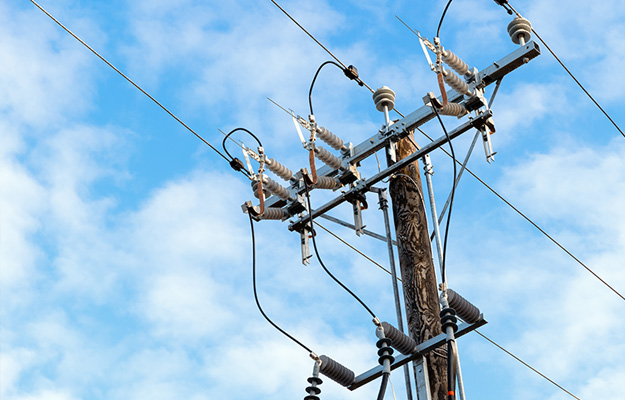
Overhead power lines are used to transmit and distribute electrical power across long distances, forming a power or national grid. Steel tower structures, pylons or wooden poles suspend electricity-carrying conductors across a range of operating voltages.
Business and residential consumers are normally supplied by high, medium and low voltage lines that are categorized depending on their destinations. High voltage transmission lines are considered to be from 69KV up to around 100KV for bulk transmission to large consumers. Medium voltage sub-transmission lines are between 1KV and 69KV for distribution in urban and rural areas. Low voltage distribution lines are below 1KV and likely destined for residential or small business consumers.

In the USA, overhead power lines are more common due to the life-cycle cost of those underground, being 2-4 times the cost of overhead. Underground cables are also more likely subject to ground movement. The North American bulk electric system consists of more than 360,000 miles of transmission lines, including approximately 180,000 miles of high voltage lines. Transmission systems are generally administered by a Regional Transmission Organization (RTO) or an Independent System Operator (ISO) which operates the region’s electricity grid and administers the region’s wholesale electricity markets. Over 3,200 Utility companies generate, transmit and distribute electricity for sale to over 145 million customers.
Problems
Overhead power lines and their supporting infrastructure may fail over time due to ageing, natural phenomena or accidental contact by vehicles and humans, resulting in power outages and potential wildfires in dry vegetation regions if cables remain live. Conductors can sag to breach safe height limits due to fallen branches, broken insulators and failed fixtures. In hot weather cable expansion and heavy electrical loading causes sagging, along with ice formation in cold weather. Conductors can fall to ground level, especially if tensioning or supporting equipment completely fails or if a vehicle collides with a tower or pole. Rotted or poles damaged over time can also lead to the same result.
Entanglement of vehicles with overhead lines is a major problem, especially on farms. Incidents of combine harvesters, cranes, tipping trailers, Hiab loader cranes and mobile elevated work platforms contacting power lines have been widely reported. The UK’s CAA and distribution network operators recommend a 50m exclusion zone for drone operation near overhead lines. Other associated problems include anglers getting fishing lines entangled, kites and metallic helium balloons coming into contact and trees growing too close or through distribution power lines. In the USA, power outages due to weather are the most common type of disruptive events. These events include hurricanes, tropical storms, tornadoes, snow and ice storms and flooding.
Safety
In the UK, the Health & Safety Executive (HSE) publish guidance notes for the construction, agriculture and tree care industries when working near overhead power lines. This includes planning and preparation, eliminating danger, controlling access and work. It also gives information as to the procedures to follow if a worker or vehicle does come into contact with a conductor. In the period 2012 to 2016, over 3000 haulage and transport vehicles were reported to have come into contact with overhead power lines, resulting in 59 people receiving injuries. In the last five years, there have been more than 1,140 near misses involving electricity on farmland. Eight people have been killed in the last two years.
In the USA, the Electrical Safety Foundation International (ESFI) is a non-profit organization dedicated exclusively to promoting electrical safety at home and in the workplace. It states that 36% of all electrically-related workplace fatalities were caused by overhead power lines between 2011 and 2017.
Reported Incidents
July 2012 (UK) – A jogger running on a footpath came into contact with an 11KV power cable. Sections of a porcelain insulator had disintegrated on a wooden pole which supported the cable, causing it to sag.
August 2012 (USA) – Two employees in a boom truck were installing a billboard sign when a piece of metal conduit used to secure the sign came into contact with an energized power line. Both employees suffered electrical burns, one of them was later pronounced dead in hospital.
2017 (UK) – An 18-year-old was electrocuted when he stepped out of his tractor cab after his tipping trailer came into contact with an overhead line.
October 2018 (USA) – Two employees were operating a concrete pump truck when the boom and hose touched an overhead power line carrying 13KV. Both employees were electrocuted.
February 2019 (UK) – A member of the public in the Western Isles moved fallen high voltage overhead power lines across a main road. Fortunately, the cable was not live.
July 2019 (USA) – An employee was operating a Skytrax telehandler traveling to a staging area to pick up roofing materials. The boom was in the elevated position and made contact with an energized 69KV power line. The employee was electrocuted.
August 2019 (UK) – A 12-year-old boy was killed after he was believed to be swinging a cable on a railway bridge when it came into contact with a power line.
September 2019 (UK) – Western Power Distribution (WPD) issued a warning after responding to three incidents in which hot air balloons came into contact with overhead lines in the previous 18 months.
CNIguard’s OverLine is an Overhead Line Monitoring System (OHLMS) that monitors the integrity of overhead conductors and poles used to distribute low and medium voltage electricity. The scalable solution addresses public and worker safety, alerting electricity distribution network operators to immediate infrastructure incidents or failures to improve performance and response to events.
Find out more about OverLine here or contact us to request a full product demonstration.
USA Headquarters
8601 Dunwoody Place
Suite 303
Sandy Springs
GA 30350
United States
T: +1-212-764-0100
Edinburgh Innovation Center
14 S Charlotte Street
Edinburgh EH2 4AX
United Kingdom





 Jason Wilson
Jason Wilson